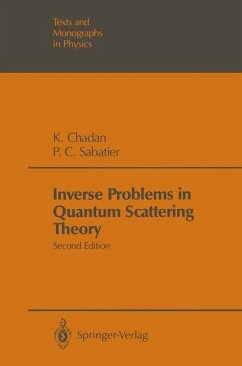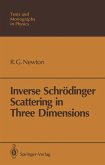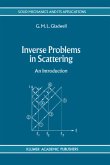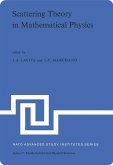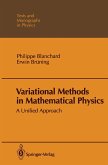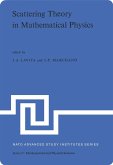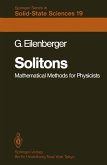Khosrow Chadan, Pierre C. Sabatier
Inverse Problems in Quantum Scattering Theory
Mitarbeit: Newton, R.G.
Khosrow Chadan, Pierre C. Sabatier
Inverse Problems in Quantum Scattering Theory
Mitarbeit: Newton, R.G.
- Broschiertes Buch
- Merkliste
- Auf die Merkliste
- Bewerten Bewerten
- Teilen
- Produkt teilen
- Produkterinnerung
- Produkterinnerung
The normal business of physicists may be schematically thought of as predic ting the motions of particles on the basis of known forces, or the propagation of radiation on the basis of a known constitution of matter. The inverse problem is to conclude what the forces or constitutions are on the basis of the observed motion. A large part of our sensory contact with the world around us depends on an intuitive solution of such an inverse problem: We infer the shape, size, and surface texture of external objects from their scattering and absorption of light as detected by our eyes. When we use…mehr
Andere Kunden interessierten sich auch für
![Inverse Methods in Action Inverse Methods in Action]() Inverse Methods in Action78,99 €
Inverse Methods in Action78,99 €![Inverse Schrödinger Scattering in Three Dimensions Inverse Schrödinger Scattering in Three Dimensions]() Roger G. NewtonInverse Schrödinger Scattering in Three Dimensions39,99 €
Roger G. NewtonInverse Schrödinger Scattering in Three Dimensions39,99 €![Inverse Problems in Scattering Inverse Problems in Scattering]() Graham M. L. GladwellInverse Problems in Scattering149,99 €
Graham M. L. GladwellInverse Problems in Scattering149,99 €![Scattering Theory in Mathematical Physics Scattering Theory in Mathematical Physics]() Scattering Theory in Mathematical Physics39,99 €
Scattering Theory in Mathematical Physics39,99 €![Variational Methods in Mathematical Physics Variational Methods in Mathematical Physics]() Philippe BlanchardVariational Methods in Mathematical Physics38,99 €
Philippe BlanchardVariational Methods in Mathematical Physics38,99 €![Scattering Theory in Mathematical Physics Scattering Theory in Mathematical Physics]() J.A. Lavita (ed.) / J.P. MarchandScattering Theory in Mathematical Physics95,99 €
J.A. Lavita (ed.) / J.P. MarchandScattering Theory in Mathematical Physics95,99 €![Solitons Solitons]() Guido EilenbergerSolitons77,99 €
Guido EilenbergerSolitons77,99 €-
-
-
The normal business of physicists may be schematically thought of as predic ting the motions of particles on the basis of known forces, or the propagation of radiation on the basis of a known constitution of matter. The inverse problem is to conclude what the forces or constitutions are on the basis of the observed motion. A large part of our sensory contact with the world around us depends on an intuitive solution of such an inverse problem: We infer the shape, size, and surface texture of external objects from their scattering and absorption of light as detected by our eyes. When we use scattering experiments to learn the size or shape of particles, or the forces they exert upon each other, the nature of the problem is similar, if more refined. The kinematics, the equations of motion, are usually assumed to be known. It is the forces that are sought, and how they vary from point to point. As with so many other physical ideas, the first one we know of to have touched upon the kind of inverse problem discussed in this book was Lord Rayleigh (1877). In the course of describing the vibrations of strings of variable density he briefly discusses the possibility of inferring the density distribution from the frequencies of vibration. This passage may be regarded as a precursor of the mathematical study of the inverse spectral problem some seventy years later.
Produktdetails
- Produktdetails
- Theoretical and Mathematical Physics
- Verlag: Springer, Berlin
- Artikelnr. des Verlages: 978-3-642-83319-9
- 2. Aufl.
- Seitenzahl: 536
- Erscheinungstermin: 8. Dezember 2011
- Englisch
- Abmessung: 235mm x 155mm x 29mm
- Gewicht: 802g
- ISBN-13: 9783642833199
- ISBN-10: 3642833195
- Artikelnr.: 36115685
- Herstellerkennzeichnung Die Herstellerinformationen sind derzeit nicht verfügbar.
- Theoretical and Mathematical Physics
- Verlag: Springer, Berlin
- Artikelnr. des Verlages: 978-3-642-83319-9
- 2. Aufl.
- Seitenzahl: 536
- Erscheinungstermin: 8. Dezember 2011
- Englisch
- Abmessung: 235mm x 155mm x 29mm
- Gewicht: 802g
- ISBN-13: 9783642833199
- ISBN-10: 3642833195
- Artikelnr.: 36115685
- Herstellerkennzeichnung Die Herstellerinformationen sind derzeit nicht verfügbar.
I Some Results from Scattering Theory.- I.1 The Reduced Radial Schrödinger Equation.- I.2 The Regular Solution: S-Wave (l = 0).- I.3 The Jost Solution: S-Wave (l = 0).- I.4 The Jost Function and the Phase Shift.- I.5 Higher Waves.- I.6 Singular Potentials.- I.7 Comments and References.- II Bound States-Eigenfunction Expansions.- II.1 Bound States: The Levinson Theorem.- II.2 Integral Representation for the Jost Function.- II.3 Eigenfunction Expansion.- II.4 Miscellaneous Results.- II.5 Singular Potentials.- II.6 Comments and References.- III The Gel'fand-Levitan-Jost-Kohn Method.- III.1 The Povzner-Levitan Representation.- III.2 The Gel'fand-Levitan Integral Equation.- III.3 Krein's Equation.- III.4 Higher Waves.- III.5 More General Equations.- III.6 Concluding Summary of the Method.- III.7 Comments and References.- IV Applications of the Gel'fand-Levitan Equation.- IV.1 Introduction of New Bound States.- IV.2 Phase Equivalent Potentials.- IV.3 Bargmann Potentials.- IV.4 Transformations of the Schrödinger Equation.- IV.5 Comments and References.- V The Marchenko Method.- V.1 The Levin Representation.- V.2 The Marchenko Integral Equation.- V.3 Comments and References.- VI Examples.- VI.1 Bargmann Potentials.- VI.2 Singular Potentials.- VI.3 Comments and References.- VII Special Classes of Potentials.- VII.1 Yukawa Potentials and the Direct Problem.- VII.2 Yukawa Potentials and the Inverse Problem.- VII.3 Higher Waves-Coulomb Potential.- VII.4 Holomorphic Potentials.- VII.5 Comments and References.- VIII Nonlocal Separable Interactions.- VIII.1 The Direct Problem.- VIII.2 The Inverse Problem.- VIII.3 More General Interactions.- VIII.4 Applications.- VIII.5 Comments and References.- IX Miscellaneous Approaches to the Inverse Problems at Fixed l.- IX.1Generalization to Other Central Potentials.- IX.2 Krein's Approach.- IX.3 Systems of Equations.- IX.4 Coupled Channels.- IX.5 Relativistic Problems.- IX.6 Discrete Forms of the Methods.- IX.7 Dispersion Relation Approach.- IX.8 Energy Dependent Potentials.- IX.9 Miscellaneous Results.- X Scattering Amplitudes from Elastic Cross Sections.- X.1 Introduction.- X.2 Constructive Methods.- X.3 Other Uniqueness Studies.- X.4 Local Results.- X.5 Uniqueness and Stability: A Reassessment.- X.6 Generalizations.- X.7 Comments and References.- XI Potentials from the Scattering Amplitude at Fixed Energy: General Equation and Mathematical Tools.- XI.1 Introduction.- XI.2 The Transformation Kernel.- XI.3 The Symmetric Kernel and the Integral Equation.- XI.4 The General Machinery.- XI.5 Further Study of the Integral Equation.- XI.6 Remarks on This Chapter.- XI.7 Connection Between the Problem at Fixed E and the Problem at Fixed l.- XII Potentials from the Scattering Amplitude at Fixed Energy: Matrix Methods.- XII.1 Introduction.- XII.2 A Method in Which the Index ? Runs Through Integers.- XII.3 Inversion of the Matrix M and Other Properties.- XII.4 Construction of cl from tan ?l.- XII.5 Construction of V(r)-Consistency of the Method.- XII.6 Generalized Matrix Methods.- XII.7 Miscellaneous Results.- XII.8 Interpolation Properties.- XII.9 Limitation of the Matrix Methods.- XIII Potentials from the Scattering Amplitude at Fixed Energy: Operator Methods.- XIII.1 Introduction.- XIII.2 Method for Potentials of the Yukawa Class.- XIII.3 Methods Using the Spectrum of the Schrödinger Operator.- XIII.4 Complete Solution.- XIII.5 Remarks on the Methods.- XIV The Three-Dimensional Inverse Problem.- XIV.1 Introduction.- XIV.2 New Outline of One-Dimensional Methods.- XIV. 3 Approach of theThree-Dimensional Problem Based on Faddeev's Green's Function.- XIV.4 Consistency and ?-Approaches.- XIV.5 Other Approaches in the Frequency Domain.- XIV.6 Time-Domain Inverse Scattering Theory.- XIV.7 Comments and References.- XV Miscellaneous Approaches to Inverse Problems at Fixed Energy.- XV.1 Methods Using Interpolation Properties.- XV.2 Methods Using Generalized Translation Operators.- XV.3 Remark on the Results Given in This Chapter.- XVI Approximate Methods.- XVI.1 Introduction.- XVI.2 Born Approximation.- XVI.3 The Semiclassical Approximation I.- XVI.4 Semiclassical Analysis II.- XVI.5 Semiclassical Analysis III.- XVI.6 From Approximate to Exact Methods.- XVI.7 Semiclassical Studies in Other Fields.- XVII Inverse Problems in One Dimension.- XVII.1 Introduction.- XVII.2 The Inverse Problem: Approaches Related with a Marchenko Equation.- XVII.3 The Inverse Problem: Other Approaches.- XVII.4 More General One-Dimensional Problems.- XVII.5 Comments and References.- XVII.A Appendix (Exercises for Readers).- XVIII Problems Connected with Discrete Spectra.- XVIII. 1 Introduction.- XVIII.2 Relations with Other Problems and Extensions.- XVIII.3 Inverse Problem in the Coupling Constant.- XVIII.4 Comments and References.- XIX Numerical Problem.- XIX.1 Introduction.- XIX.2 Numerical Methods for Local Potentials.- XIX.3 Numerical Methods for Inverse Spectral Problems.- XIX.4 Nonlocal Potentials.- Reference List.
I Some Results from Scattering Theory.- I.1 The Reduced Radial Schrödinger Equation.- I.2 The Regular Solution: S-Wave (l = 0).- I.3 The Jost Solution: S-Wave (l = 0).- I.4 The Jost Function and the Phase Shift.- I.5 Higher Waves.- I.6 Singular Potentials.- I.7 Comments and References.- II Bound States-Eigenfunction Expansions.- II.1 Bound States: The Levinson Theorem.- II.2 Integral Representation for the Jost Function.- II.3 Eigenfunction Expansion.- II.4 Miscellaneous Results.- II.5 Singular Potentials.- II.6 Comments and References.- III The Gel'fand-Levitan-Jost-Kohn Method.- III.1 The Povzner-Levitan Representation.- III.2 The Gel'fand-Levitan Integral Equation.- III.3 Krein's Equation.- III.4 Higher Waves.- III.5 More General Equations.- III.6 Concluding Summary of the Method.- III.7 Comments and References.- IV Applications of the Gel'fand-Levitan Equation.- IV.1 Introduction of New Bound States.- IV.2 Phase Equivalent Potentials.- IV.3 Bargmann Potentials.- IV.4 Transformations of the Schrödinger Equation.- IV.5 Comments and References.- V The Marchenko Method.- V.1 The Levin Representation.- V.2 The Marchenko Integral Equation.- V.3 Comments and References.- VI Examples.- VI.1 Bargmann Potentials.- VI.2 Singular Potentials.- VI.3 Comments and References.- VII Special Classes of Potentials.- VII.1 Yukawa Potentials and the Direct Problem.- VII.2 Yukawa Potentials and the Inverse Problem.- VII.3 Higher Waves-Coulomb Potential.- VII.4 Holomorphic Potentials.- VII.5 Comments and References.- VIII Nonlocal Separable Interactions.- VIII.1 The Direct Problem.- VIII.2 The Inverse Problem.- VIII.3 More General Interactions.- VIII.4 Applications.- VIII.5 Comments and References.- IX Miscellaneous Approaches to the Inverse Problems at Fixed l.- IX.1Generalization to Other Central Potentials.- IX.2 Krein's Approach.- IX.3 Systems of Equations.- IX.4 Coupled Channels.- IX.5 Relativistic Problems.- IX.6 Discrete Forms of the Methods.- IX.7 Dispersion Relation Approach.- IX.8 Energy Dependent Potentials.- IX.9 Miscellaneous Results.- X Scattering Amplitudes from Elastic Cross Sections.- X.1 Introduction.- X.2 Constructive Methods.- X.3 Other Uniqueness Studies.- X.4 Local Results.- X.5 Uniqueness and Stability: A Reassessment.- X.6 Generalizations.- X.7 Comments and References.- XI Potentials from the Scattering Amplitude at Fixed Energy: General Equation and Mathematical Tools.- XI.1 Introduction.- XI.2 The Transformation Kernel.- XI.3 The Symmetric Kernel and the Integral Equation.- XI.4 The General Machinery.- XI.5 Further Study of the Integral Equation.- XI.6 Remarks on This Chapter.- XI.7 Connection Between the Problem at Fixed E and the Problem at Fixed l.- XII Potentials from the Scattering Amplitude at Fixed Energy: Matrix Methods.- XII.1 Introduction.- XII.2 A Method in Which the Index ? Runs Through Integers.- XII.3 Inversion of the Matrix M and Other Properties.- XII.4 Construction of cl from tan ?l.- XII.5 Construction of V(r)-Consistency of the Method.- XII.6 Generalized Matrix Methods.- XII.7 Miscellaneous Results.- XII.8 Interpolation Properties.- XII.9 Limitation of the Matrix Methods.- XIII Potentials from the Scattering Amplitude at Fixed Energy: Operator Methods.- XIII.1 Introduction.- XIII.2 Method for Potentials of the Yukawa Class.- XIII.3 Methods Using the Spectrum of the Schrödinger Operator.- XIII.4 Complete Solution.- XIII.5 Remarks on the Methods.- XIV The Three-Dimensional Inverse Problem.- XIV.1 Introduction.- XIV.2 New Outline of One-Dimensional Methods.- XIV. 3 Approach of theThree-Dimensional Problem Based on Faddeev's Green's Function.- XIV.4 Consistency and ?-Approaches.- XIV.5 Other Approaches in the Frequency Domain.- XIV.6 Time-Domain Inverse Scattering Theory.- XIV.7 Comments and References.- XV Miscellaneous Approaches to Inverse Problems at Fixed Energy.- XV.1 Methods Using Interpolation Properties.- XV.2 Methods Using Generalized Translation Operators.- XV.3 Remark on the Results Given in This Chapter.- XVI Approximate Methods.- XVI.1 Introduction.- XVI.2 Born Approximation.- XVI.3 The Semiclassical Approximation I.- XVI.4 Semiclassical Analysis II.- XVI.5 Semiclassical Analysis III.- XVI.6 From Approximate to Exact Methods.- XVI.7 Semiclassical Studies in Other Fields.- XVII Inverse Problems in One Dimension.- XVII.1 Introduction.- XVII.2 The Inverse Problem: Approaches Related with a Marchenko Equation.- XVII.3 The Inverse Problem: Other Approaches.- XVII.4 More General One-Dimensional Problems.- XVII.5 Comments and References.- XVII.A Appendix (Exercises for Readers).- XVIII Problems Connected with Discrete Spectra.- XVIII. 1 Introduction.- XVIII.2 Relations with Other Problems and Extensions.- XVIII.3 Inverse Problem in the Coupling Constant.- XVIII.4 Comments and References.- XIX Numerical Problem.- XIX.1 Introduction.- XIX.2 Numerical Methods for Local Potentials.- XIX.3 Numerical Methods for Inverse Spectral Problems.- XIX.4 Nonlocal Potentials.- Reference List.

